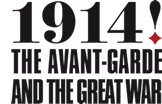
“War has increased poetry’s power over me even more”, Guillaume Apollinaire wrote during the time of the conflict. The poet was at the Front from April 1915 until he was wounded by a shell in March 1916. The Front, where Apollinaire wrote and produced drawings and calligrammes, was also a fertile terrain for other poets and artists who had been called up such as André Mare, David Bomberg and numerous others. This art produced at the Front, with its notes and drawings executed at the very heart of the combat, documents these creative figures’ most immediate relationship with the war. Cubism and other artistic idioms characteristic of the avant-garde were used as an interpretative guide that conformed to the nature of the subjects. We thus witness a unique fusion between Cubism’s mode of faceting, superimposition, lines of force and other formal devices and the art of the Front, including subjects from the trenches, the combat, artillery action, explosions and field hospitals. The closest possible affinity between the mechanised nature of the new language and the dynamic of the reality of the war manifests itself in these creations, which seem to respond to their new place of creation, shifted from the avant-garde art studio to the front line. This section brings together a comprehensive and wide-ranging selection of works on paper. Among the artists included, there are particularly large and important representations of the work of Fernand Léger, William Roberts, Wyndham Lewis and Otto Dix.
![]()
  |
|---|





